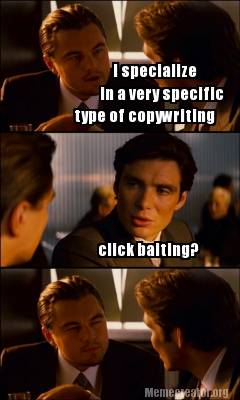Focus on Copywriting: Sell without Selling
While most startups can’t afford an in-house copywriter, most companies also can’t afford not to have someone focus on copywriting, at least some of the time.
Why you Should Focus on Copywriting
“Language ties together the worlds of reality and possibility”Last year, Jason Cohen wrote about developing his “story,” the many years of selling Smart Bear, a successful code-review tool. I’ll quote part of the text here (with permission), and encourage you to read the entirety.
|
At first when someone asked what my company’s tool suite was, I would say: “Smart Bear makes data-mining tools for version control systems”. It’s a description so esoteric that, although accurate, not even a hardcore geek would have any idea what it is, much less why it’s useful. Years later, when it was clear that code review software became our sole focus, I got better at describing it: You know how Word has “track changes” where you can make modifications and comments and show them to someone else? We do that for software developers, integrating with their tools instead of Word and working within their standard practices. Better, yes, and for a while I thought I nailed it, but still no press. Eventually (thanks to helpful journalists) I realized I was still just describing what it is rather than why anyone cares. I left it up to the reader to figure out why they should get excited. Eventually I developed stories like the following, each tuned to a certain category of listener. Here’s the one for the journalists: It’s always fun to tell a journalist like you that we enable software developers to review each other’s code because your reaction is always: “Wait a minute, you’re seriously telling me they don’t do this already?” The idea of editing and review is so embedded in your industry you can’t imagine life without it, and you’re right! You know better than anyone how another set of eyeballs finds important problems. Of course two heads are better than one, but developers traditionally work in isolation, mainly because there’s a dearth of tools which help teams bridge the social gap of an ocean, integrate with incumbent tools, and are lightweight enough to still be fun and relevant. That’s what we do: Bring the benefits of peer review to software development. Now the reason for excitement is clear: We’re transforming how software is created, applying the age old techniques of peer review to an industry that needs it but where it’s traditionally too hard to do. – See more at Cohen’s own Smart Bear Blog |
Part of the conundrum of good copywriting is that it is virtually impossible to test. A homepage layout can be dissected into precise quanta of effectiveness: how many visitors, how many clicks, how many page views; the flow of traffic is orderly and can be controlled. You can A/B test adwords and landing pages and see “what works,” but you’ll only ever be finding out what doesn’t fail as much- not how well you could be doing. There’s no A/B test for a truly novel approach; one that builds momentum for your site and your products, because two novel approaches will not be binary in nature. They will not be comparable at all.
Because copy doesn’t work like code, but a lot of web entrepreneurs assume it does. If the copy “doesn’t work,” it’s the fault of the copy, not what the copy supports (ie: the product, or the company).
Build Your “Story,” And Your Voice
Copywriting, done well, can increase a site’s conversion rate enormously. It can entice new customers and woo old ones to stick around. But most early startups stick with their old copywriting for too long.
You can’t test copy like you can a layout or a button or a piece of code: it’s too complex- there are too many emotions, too many subtle cultural cues, and too many ways in which people read; all of them different.* And even more, it’s reactive- your copy has to evolve with time, coming to acknowledge your existing customers and community, and what your products mean to them, along with attracting new customers. Jason Cohen’s “story,” as it evolved above was changed to acknowledge whom he was talking to about his products, and what they need to really understand about them. He went from a programmer with an idea, to a trustworthy person with a solid background in helping people with his products. And his story showed that.
________________________________________________
*Our CEO Cedric Maloux disagrees with me on this point.
Cedric: I used to have 4 different homepages. All similar, except for one headline. And I was measuring which one was leading to more sales in real time. The software would show one or the other and measure the reactions. This is A/B testing at it’s best- you can test a headline, but you can’t test all the copy.Cedric makes a fair point here. Headlines, tag lines and slogans often work more like static features of a website than the rest of the copy does. Because they don’t take on all of the same responsibilities as normal marketing copy, you can and should treat them as testable. These are the elements of your copy that stand up best to focus-grouping and testing, because their purposes are more unique- namely to attract clicks and push a visitor to go further.
_______________________________________________
This is not to say that you should never speak in technical jargon, but that you should always know whom you’re talking to, how much they know, and how hard they’re listening. Your copy needs to evolve to reflect the culture of your company and your customers.
But in the data-driven world of online marketing, these organic, real, contextually rich evolutions are rarely allowed to happen. It’s rare in this world to see something closer to the corporate ad-agency driven model, in which a creative and an account executive sell campaigns to a client, who then uses the creative output to tell a new story. More often it’s the case that the better is the enemy of the good: that founders and CEOs are unwilling to try anything that smacks of the entirely new, because it can’t be reliably tested, and requires a great deal of faith. Even though truly original great ideas have, necessarily, never been tried before.
In the current startup ecosystem, ambitions for zero-cost growth have become dangerously intertwined with risk-aversity: companies shrink from the prospect of *losing* small levels of growth, in a gambit for gaining more. And not a small number of companies have played the same tune for too long- failing to pivot their messaging until their revenue has shrunk enough for it to be too late, and changes will only appear desperate and cynical (which they will be).
This is a shame in some respects, as the quality of language on a website is just as important in conveying impressions of honesty, competence, and skill as a quality design is. Perhaps even more so, as web design becomes increasingly automated and pre-packaged. Copy cannot be automated or prepackaged. It always has to be unique. Language ties together the worlds of reality and possibility. It is the medium in which you make your ideas real for your customers: in which you construct the reality of your products, and a future world in which your customers use them. That’s a vitally important thing to focus on.
Write Honestly: Sell Without Selling
I had a great sales manager once you who taught me what he called the “7 Things” that you have to keep in mind when you talk to a customer. It was based on a simple principle: when you talk to customers, you are always selling something.
Before we go all Glengarry Glen Ross here, this is not the same as the old adage: “Always be Closing.”
The important thing is to remember what your relationship to a customer is, and to be very honest about that fact. You will never sell someone something they don’t want to buy. And even if you do manage it once, they will never buy twice, so you shouldn’t sugar coat or lie about your products, ever. You don’t need to. Just follow these “7 Things.”
Trust: In you and the product. Let the customer do what they would normally do.
Understanding: Be as simple and clear as possible. The customer is not smarter than you.
Emotions: Use humor, use evocative words, show love and caring. Show passion.
What to do: Buy, sign up, share…
When to do it: Now?
What I get out of it: Speak about effects of the product, not the features.
When it will happen: Examples, case studies, quotes, and testimonials
The list is a simple one to follow, and you should look for every point to be covered in some way in your communications with customers (eg: on your homepage, landing pages, email contacts, and other sales material).
Most important of the above is trust. My sales manager would say this: “If I asked you to show me 4 fingers, what would you do?” I held up 4 fingers on one hand. He said, “Exactly. Now, if I held up 2 fingers on each hand, you would think I was being a smartass.” This is to say, that trust is established by doing what the customer expects, and by showing that you understand the customer well. You have thought this through, and you understand what the customer needs.
Then you can access emotions. Emotions can be descriptive words, or appeals to imagination. But emotions must be appealed to after trust and understanding are established. Customers are looking for an emotional connection to anything they buy. If they feel they’re dealing with a real person, who wants and cares about their business, then they will be more than ready to come back and buy again.
What the Customer Gets Out of It
Surprisingly, this is an element of a lot of online copywriting that gets completely lost. Companies don’t talk about what their products mean to people. They just talk about what their products do and are. That’s a major problem.
While you might describe your product idea as: “A non-SQL back-end solution for tracking PPC traffic ROI,” I might describe that same idea as: “A tool that helps online businesses figure out whether their web ad dollars are being spent wisely.” While my version tells you practically nothing important about how the product works, it does tell you what the product does. It speaks about effects rather than features of the product. It focuses on what is important to a client, an investor, or a customer: what the product accomplishes.
This is important especially for non B2B products, but generally any time in which the client is significantly different, as an entity, from your company. And even if you’re an IT company selling IT resources to be used by IT people, the person actually in charge of buying those products or services is probably not the one who will be using them.

Your copywriter has to concern him or herself with these distinctions: how product copywriting (such as product instructions, help menus, drop downs, and user messages), and marketing copywriting, such as homepages, campaign pages, and marketing communications, are fundamentally different, and meant often for fundamentally different people. I can’t tell you how many times I’ve seen the same mistakes made: websites for complex and expensive products that use a product copywriting style, right on the homepage. You might as well add a light-box on the homepage that pops up and says: “If you haven’t already committed to buying this product, don’t bother going forward.” The person who is viewing your homepage may not be a customer, and treating them like a customer (with product copywriting), is often a big mistake.
Because before a person is your customer, you need to establish trust. And that means giving that person a way of understanding who you are, and what you do, and of liking you. If you haven’t done that, then the customer is taking a risk in buying from you. And most sales, you’ll lose that customer.
If it’s work for the buyer to figure out what your product is, then it’s going to be nearly impossible to sell to them. And unless you’re in the enviable position of a product company that has its client-base beating down its door to buy the latest release, then you need to think about this. A lot of the time, the person your product is meant for, and the person your product will be used by, are two totally different people. And you need to assume the worst.
[ssba]





